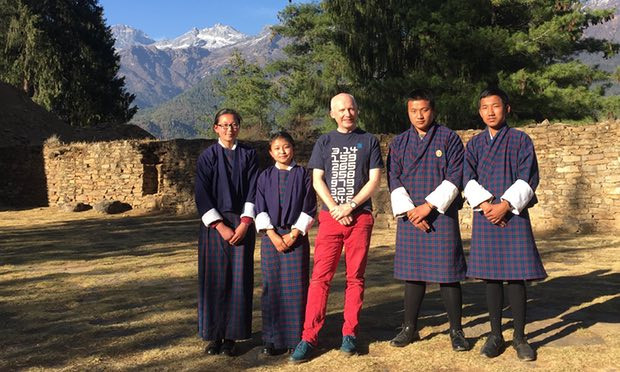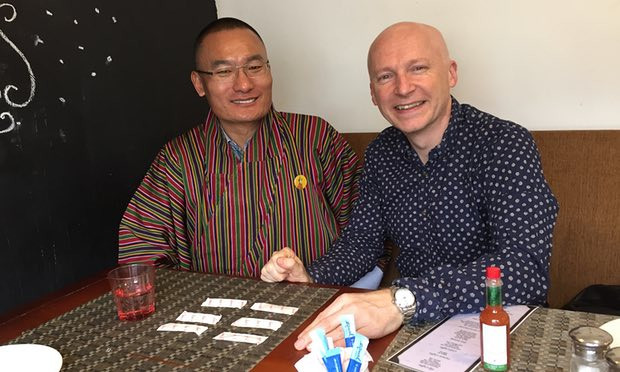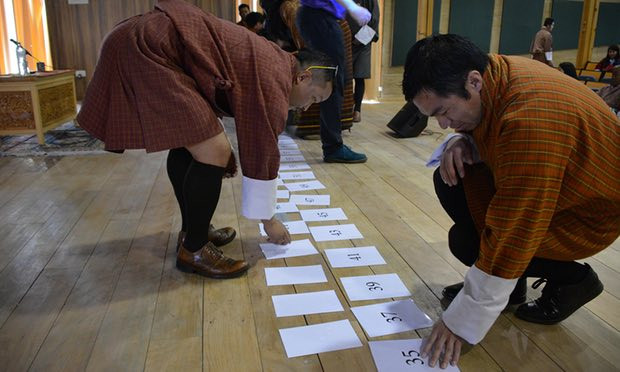Oxford professor fascinated by the way Bhutanese teach math to students
Oxford mathematician Marcus du Sautoy visited the mountain kingdom, which succeeded in inspiring children to love mathematics.
Below are his shares.
Every country in the world is struggling to solve the most difficult question in mathematics. It is not the Riemann hypothesis or the Navier-Stokes equations. It is the challenge of how to get children to love math.
 |
| Drugyel School Students |
One country taking an innovative approach to this challenge is the tiny kingdom of Bhutan, tucked away in the Himalayas. Bhutan is trying to find ways to make math lessons more fun for its children. Inspired by the Indian curriculum of memorizing rules and rote learning, this approach explains how rules work and helps students understand.
At the invitation of the Bhutan Teaching Project and with the support of the British High Commission in India, I attended a series of workshops to help teachers transition to the new curriculum. Standing in front of a large hall of teachers dressed in traditional dress, I wondered if my teaching experience at Oxford University would be enough to make a difference.
To break the ice, I started with a story about my favorite numbers: Prime numbers. After all, 17 is an indivisible number in Bhutan.
“Can you help me understand the significance of the number 108 in Buddhism?” Kesang, a teacher from Punakha Valley asked me as we were having our morning snack.
Never one to shy away from a difficult question, I said my first thought was to factorize the number into its prime numbers to see how it would look: 108 = 2x2x3x3x3.
Soon we realized this might explain part of the significance of the number 108 in Buddhism.
Kesang explained to me that Buddhists believe that humans have six senses: the five western senses plus the sixth sense of perception. These senses can be manifested in three ways: good, bad or neutral. They can also be internal or external to the body. Finally, they can be in the past, present or future. This gives (2x3) x3x2x3 = 108 different types of senses.
As we began to explore numbers more, we realized more connections to math.
I drove through the Dochula highway to the Punakha valley and stopped to take pictures of the stupas (domed Buddhist shrines).
“Do you know about the 108 stupas containing the remains of monks?”, asked Chime, a teacher from Punakha High School.
We started thinking about how the towers would be arranged. If we think of them as 108 blocks, the overall picture is pretty perfect. Arranged in a 3x3 layout, with 12 towers in each square arranged in a 3 x 4 pattern, this would make 108 towers.
This idea of mathematical connections is an important theme in the new curriculum.
Textbooks are enriched with mathematical figures intended to quickly appeal to students' imagination.
For example, the curriculum for Bhutanese students introduces the idea of fractals (representing patterns in things at all scales) and topology (explaining geometric structures).
It is this fun of math that inspires students to learn formulas, allowing them to grasp and enjoy more difficult concepts.
Jigme, a teacher at the Royal Academy, a school near Paro founded by the King of Bhutan, explained how to get students to understand the formula for calculating the area of a circle by forcing them to cut the circle into triangles.
 |
| Author and Prime Minister Tshering Tobgay talk about mathematics |
By rearranging the triangle into a rectangle, students can understand why the area of a circle is πr2. In this way, students understand why the formula exists, rather than learning it as a rule. “We found that 80% of the boredom turned into 95% of the joy in math with this new approach,” this teacher told me.
Rinchen, who is training to become a mathematics teacher at Paro College of Education, explained that this idea of connection deeply reflects one of the important features of Bhutanese Buddhist culture. “Buddhism teaches a high level of interconnectedness with the nature of the universe. Nothing is considered in isolation. It is important to see how mathematics connects with things outside the classroom.”
 |
| Thimpu Math Teacher Puts Theory into Practice |
It is a philosophy that is sorely lacking in most educational systems, where a student learns math, music, and history, but never understands how these subjects relate to each other.
However, Prime Minister Tshering Tobgay expressed concern that the curriculum may not provide the basics that students need. “It is very good to teach students how math works. But they also need to know their multiplication tables.”
The teachers I mentioned all acknowledged the exciting new potential of the program, but said it needed to be balanced with ensuring students learned the basics. As Sonam, a teacher at Drugyel High School, put it: “A musician still has to spend time learning scales as well as playing Zhungdra (traditional Bhutanese folk music).”
It is interesting to see Bhutan taking the initiative to ensure students enjoy math rather than hate it. Karma, a math teacher from Thimphu, the capital of Bhutan, says: “We are focusing too much on learning math rules. Students may know how to apply the rules at a very high level, but this rote learning does not make them enjoy it.”
When I visited Bhutan, I clearly saw the emphasis on the role of education in shaping the future of their country.
In a private interview with the King of Bhutan, he told me that he wants his people to be fluent in three languages: first, Dzongkha – the national language of Bhutan, so that they will always be connected to their unique culture; second, English because this allows them to connect and communicate with the world; third, the language of mathematics because this is the language that allows them to navigate the universe and plan for an uncertain future.
According to VNN

